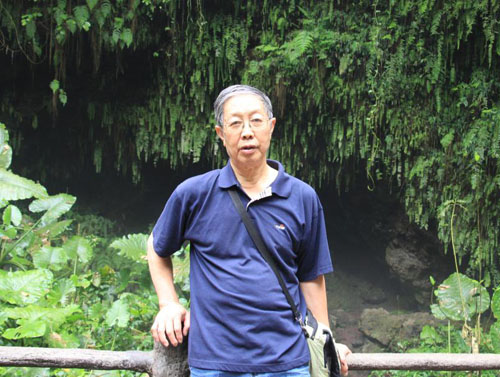
Dingsheng Wang
Researcher, academician of Chinese Academy of Sciences
Key Laboratory of Condensed Matter Theory and Computation,
Institute of Physics, Chinese Academy of Sciences
Email:dswang@iphy.ac.cn
Tel:010-82649423
Ding-sheng Wang
Career History:
1956—1962 Undergraduate, Dept. Physics, Beijing University
1962—1966 Graduate program, Institute of Physics,Academia Sinica
1966—1982 research assistant, Institute of Physics,Academia Sinica
1982—1986 Associate Professor, Institute of Physics,Academia Sinica
1986— Professor, Institute of Physics,Academia Sinica
Research Interests:
Attacking problems in the field of surface physics and magnetism by computational theoretical approaches, including study of the adsorption on metal surfaces, the magnetism of ultra-thin films, and explanation of the mechanism of the magneto-crystalline anisotropy in terms of the electronic structure. Also other properties of condensed matter, such as nonlinear optical property of crystals, and properties of battery materials.
Address:
Institute of Physics P.O.Box 603 Beijing, 100190, China
Selected Recent Publications:
1.D. S. Wang and F. C. Pu, Spin wave spectrum and excitation in finite ferro-antiferromagnetic linear chain,Acta Phys. Sinica, 20(1964), 1068, in Chinese
2.D. S. Wang, G. M. Chen and S. T. Pan,WULI, Frequency dependence of domain wall creeping in magnetic films,(J. Physics), 2(1973), 169, in Chinese
3.W. Y. Lai, D. S. Wang and F. C. Pu, Dipole-exchange spin waves in a cylindrical ferromagnet,Acta Phys. Sinica, 26(1977), 285, in Chinese
4.D. S. Wang, A. J. Freeman, H. Krakauer and M. Posternak, Self-consistent LAPW method determination of electronic structure and surface states on Al(111), Phys. Rev., B23(1981), 1685
5.D. S. Wang, A. J. Freeman and H. Krakauer, Electronic structure and magnetism of Ni overlayers on a Cu(001) substrate,Phys. Rev., B26(1982), 1340
6.W. Ning, C. Kai-lai and W. Ding-sheng,Work function of transition-metal surface with submonolayer alkali-metal coverage, Phys. Rev. Lett., 56(1986), 2759
7.D. S. Wang, R. Q. Wu and A. J. Freeman, State tracking first principles determination of magnetocrystalline anisotropy, Phys. Rev. Lett., 70(1993) 869
8.D. S. Wang, R. Q. Wu, and Freeman, First-principles theory of surface magneto-crystalline anisotropy and the diatomic pair model, Phys. Rev. B47(1993) 14932
9.Li J, Duan CG, Gu ZQ, and Wang DS, First-principles calculations of the electronic structure and optical properties of LiB3O5, CsB3O5, and BaB2O4 crystals, PHYS. REV. B, 57(1998) 6925-6932
10.Yu-mei Zhou, Ding-sheng Wang, and Yoshiyuki Kawazoe, Effective ab initio exchange integrals and magnetic phase transition in antiferromagnets fcc Fe and Mn,Phys. Rev. B59, 8387 (1999)
11.Jian-Tao Wang, Yoshiyuki Kawazoe and Ding-Sheng Wang, Magnetic phase competing in MnAu superlattices, Appl. Phys. Lett.79, 1507 (2001)
12.Jian-Tao Wang, H. Mizuseki, Y. Kawazoe, T. Hashizume, M. Naitoh, D. S. Wang, En-Ge Wang, Stability of Sb line structures on Si(001), Phys. Rev. B 67, 193307 (2003)
13.Shi SQ, Liu LJ, Ouyang CY, Wang DS, Wang ZX, Chen LQ, and Huang XJ, Enhancement of electronic conductivity of LiFePO4 by Cr doping and its identification by first-principles calculations, PHYS. REV. B, 68(2003) 195108
14.Xiangang Wan, Lei Zhou, Jinming Dong, T.K.Lee, and Ding-sheng Wang, Orbital Polarization, Surface Enhancement and Quantum Confinement in Nano-cluster Magnetism, Phys. Rev. B 69, 174414 (2004)
Tel: 86-10-82649423
Email: dswang@iphy.ac.cn
